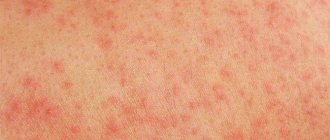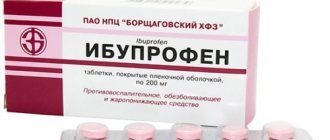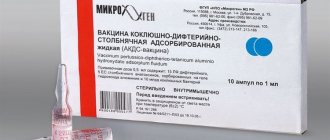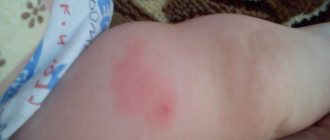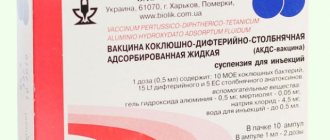Pentaxim and Infanrix hexa: what is the difference in the composition and properties of the drugs
When comparing Pentaxim and Infanrix, you need to study the components of the drugs and clarify the list of diseases that each of them protects against.
The names of the vaccines already contain information about the number of infections against which the vaccine is effective. “Penta” means “five” in Latin, so Pentaxim protects against 5 dangerous infections at once.
- Whooping cough is a disease, a clear sign of which is a hacking cough. May be complicated by pneumonia, encephalopathy, vascular and other pathologies.
- Diphtheria is a disease of the upper respiratory tract. Complications often include myocarditis, disorders of the nervous system, even paralysis and death.
- Tetanus is an acute disease characterized by damage to the nervous system, skeletal muscles, and severe (often fatal) complications that extend to the cardiovascular, respiratory, and musculoskeletal systems.
- Polio viruses of types 1, 2 and 3 cause paresis and paralysis.
- Diseases caused by the bacteria Haemophilus influenzae type b (meningitis, septicemia, pneumonia and others).
Pentaxim is produced by France. It contains 25 mcg of three pertussis antigens in acellular (cell-free) form, diphtheria and tetanus toxoids (40 and 30 IU, respectively), deactivated polio viruses in purified form, as well as a lyophilisate from crushed membranes of Haemophilus influenzae to prepare a suspension. The formula does not contain such dangerous accompanying components as mercury and phenol red. The disadvantage of this drug is the presence of aluminum hydroxide and formaldehyde in its composition.
From 2008 until recently, Pentaxim was the only drug in Russia (Infanrix Hexa was certified quite recently - in 2021) that made it possible to vaccinate a child against several dangerous diseases at once and reduce the total number of injections to five. Compared to the DTP vaccination schedule, during which you will have to visit the treatment room 12 times, Pentaxim is a more “convenient” complex drug. Its components are safe and can be used to vaccinate weakened children, without the threat of severe complications that arise when using live vaccines. The vaccination is well tolerated, so doctors recommend using it to vaccinate babies whose bodies react acutely to the components of DTP.
To reduce the antigenic load, the possibility of separate immunization against DPT infections/poliomyelitis and Haemophilus influenzae is provided. Therefore, the first group of Pentaxim components is placed in a syringe, and the Hib component is placed in a separate ampoule.
A group of vaccine drugs under the general name Infanrix is produced by the British company GlaxoSmithKline. Infanrix Hexa is an improved polyvalent vaccine that forms immunity in a child to six infections. To 3 pertussis antigens, diphtheria and tetanus toxoids (in the same concentration as in Pentaxim), an additional component is added - against the hepatitis B virus, which affects the liver and brain, leading to disability. Among the excipients: aluminum alkali and salt, emulsifier polysorbate, preservatives formaldehyde and 2-phenoxyethanol, solution for injection. The active ingredients are also presented in acellular form, all components are highly purified, so this vaccine is also well tolerated and is indicated for babies starting from the 3rd month of life.
When choosing the appropriate vaccine, you need to take into account the recommended vaccination schedule, which is very important at an early age, when children have not yet developed their immune system. The British vaccine Infanrix Hexa can be given to children from six months of age, when the hepatitis B vaccination is repeated.
This drug should be used in accordance with the planned vaccination schedule:
- from 6 months, when the DPT vaccination is due;
- with repeated vaccination against hepatitis B;
- for protection against polio.
The drugs contain antigens of different infections, their use is determined by different purposes of immunization. In a particular case, the pediatrician must decide which drug to use for immunization, taking into account all the individual indications and contraindications that the child has.
Features of the Infanrix vaccine
The main purpose of the drug is prevention against tetanus, diphtheria and whooping cough. Infanrix contains the necessary components for this:
- tetanus toxoid (40 IU);
- diphtheria toxoid (30 IU);
- three purified pertussis antigens (25 mcg) that cause the most severe symptoms during the development of the disease.
In addition to the active ingredients, the Infanrix vaccine also includes excipients:
- aluminum hydroxide and phosphate;
- polysorbate;
- formaldehyde;
- 2-phenoxyethanol;
- sodium chloride;
- and water for injections.
This seemingly complex composition provides protection against all of the above diseases and practically does not cause complications.
What else is important to know about Infanrix? This is an acellular vaccine, which means it is highly purified. Unlike conventional drugs, this one is much easier to tolerate. Infanrix can be administered to children from three months of age.
(GlaxoSmithKline) UK. The same manufacturer has an improved version of the vaccine - Infanrix Hexa, supplemented with protection against hepatitis B, polio and Haemophilus influenzae infection.
General information about vaccines, their composition and action
Since 1940, Russia has carried out universal immunization of the population. There is an approved National Vaccination Calendar, which all medical institutions adhere to. When a child is just born, he is given the first vaccinations against hepatitis B and tuberculosis.
Doctors consider the vaccine against three very dangerous, even fatal, diseases to be the main one for developing children’s immunity:
- diphtheria - an acute infectious disease that affects the upper respiratory tract,
- whooping cough, leading to pneumonia, convulsions and respiratory arrest,
- tetanus - a soil infection accompanied by seizures and problems with the nervous system.
Statistics show the seriousness of these diseases. Thus, before universal vaccination, the mortality rate from tetanus was 90%, and from diphtheria - 25%.
DTP is the name of the vaccine drug produced in Russia, but for convenience, this is what all vaccines against these diseases are called. Foreign vaccines differ from Russian ones in many characteristics.
The imported ones do not contain formalin and merthiolate, since these substances are prohibited in the USA and the European Union. They also lack the acellular anti-pertussis component, which is why they are better tolerated by children of any age.
Many foreign vaccines are produced in combination against polio, hepatitis B and other diseases. However, they are not included in the child’s health insurance, and such vaccinations will have to be paid for.
INTERESTING: how is the polio vaccine given?
Domestic vaccine DTP
At the clinic, by default, the baby will be given the Russian vaccine for free. It is inexpensive, compared to Pentaxim and Infanrix, and not very modern. It contains dead pertussis germs, diphtheria and tetanus toxoid.
Toxoids are widely used in the production of vaccines. They are produced by pathogens, but after heat treatment they become harmless. At the same time, toxoids retain antigenic activity, that is, they form immunity in the child.
Merthiolate (thiomersal), an organometallic compound of mercury, is used as a preservative, antiseptic, and also to protect against fungus. This is a dangerous substance, very toxic, carcinogenic, causes allergies, and is a mutagen.
The dose of merthiolate contained in the domestic vaccine is not dangerous for a small child. However, in the body of a newborn, the level of mercury compounds after immunization decreases only after a month. It is this compound that often causes parents to refuse vaccination with Russian drugs.
DPT is used only up to the age of 4 years. When choosing which vaccine to vaccinate your baby with, you should remember that the domestic vaccine has been approved by WHO.
French vaccine Pentaxim
There is a French vaccine similar to DPT. Unlike the domestic one, it also protects the baby from polio and hemophilus influenzae infection. Pentaxim additionally contains inactivated polio virus, and the whooping cough virus in its composition is split and its shell is removed.
READ ALSO: how to properly prepare for DTP vaccination?
In addition, unlike DPT and the polio vaccine, Pentaxim is better tolerated. It reduces the risk of developing vaccine-associated polio, that is, caused specifically by vaccination. This is also evidenced by multiple reviews of parents about the vaccine on the Internet.
Belgian vaccines Infanrix and Infanrix Hexa
In addition to the French vaccine Pentaxim, there is another drug on the Russian pharmacy market - the Belgian analogue Infanrix. It is intended for vaccination against whooping cough, diphtheria and tetanus. Includes components similar to the French vaccine.
The drug Infanrix Hexa additionally contains a vaccine against hepatitis B, Haemophilus influenzae and polio. It additionally contains neomycin and polymyxin. The vaccine is contraindicated if you are sensitive to antibiotics. Parents' subjective assessment of this drug is also very high.
READ IN DETAIL: Why is the Infanrix vaccine given to children?
Cases of allergic reactions to Pentaxim and Infanrix vaccines
When using the drugs Pentaxim and Infanrix in children, allergic reactions were observed very rarely during the first and subsequent administrations of the vaccine. There have been cases of hives and rashes appearing on the skin. Hypotension may also develop. In isolated cases, children exhibited febrile and afebrile seizures. However, the possibility of more serious complications cannot be ruled out. Urgent treatment is required in cases of anaphylactic reactions, including shock. That is why there should be anti-shock drugs in the room where the vaccination procedure is carried out. In rare cases, babies may develop an allergic reaction in the form of swelling of the lower extremities. It is difficult to answer the question of how Infanrix differs from Pentaxim. Both drugs cause similar allergic reactions, which, however, are observed relatively rarely.
Which is better to vaccinate with DTP: imported or domestic?
Which is better to get the DTP vaccine, domestic or imported, each parent decides independently. Much depends on the financial situation, the health of the baby, the tolerability of individual components of the vaccine, and the availability of the required drug in the pharmacy.
A pediatrician can help with the choice. To make the right decision, it is worth considering the positive and negative aspects of foreign and Russian DTP.
Advantages of the domestic pertussis-diphtheria-tetanus vaccine:
- no need to search for the drug in pharmacies. DPT is available in public health clinics and hospitals;
- Vaccination is carried out free of charge within the established schedule.
Disadvantages of the Russian drug:
- sometimes causes local and general adverse reactions;
- in some cases it can provoke serious complications such as meningitis, encephalitis;
- efficiency does not exceed 80-85%;
- may not be well tolerated by weakened children and allergy sufferers.
Advantages of imported analogues of DTP:
- are produced using a special technology that minimizes the load on the child’s body and reduces the likelihood of adverse reactions and complications;
- do not contain whooping cough, Tween-80, or merthiolate in whole cells, which negatively affect the baby’s health;
- form immunity to 4-5 viral and infectious pathologies at once. This allows you to reduce the number of injections, minimize the number of visits to the doctor, and reduce stress for the child;
- protection efficiency is at least 95%;
- have a more convenient release form. The injection solution is packaged in a syringe in a single dose. This makes the manipulation easier;
- Suitable for immunization of weakened children and persons prone to allergic reactions and seizures.
Disadvantages of foreign vaccinations:
- sometimes provokes adverse reactions of a local and general nature;
- in some cases it can provoke serious complications;
- the need to purchase the drug at the pharmacy;
- the product is not always available at points of sale;
- high cost of vaccination.
Vaccine Infanrix
If parents have enough financial resources, a foreign drug should be chosen for those children who are prone to allergic conditions and seizures. It is also better for weakened persons to inject Pentaxim or Infanrix instead of DPT.
Pediatricians note that allergies and other adverse reactions may also occur with Infanrix, Pentaxim, Tetracok and Tritanrix NV. Doctors advise choosing a drug based on the child’s health condition.
If the child does not have any special conditions or the budget does not allow purchasing an imported analogue, then vaccination can be performed with a domestic drug. In most children, this drug is well tolerated and does not cause any significant changes in well-being.
Special instructions for vaccination
Before the vaccination procedure, the pediatrician is obliged to study the medical history of the small patient. It is necessary to pay attention to the previous administration of drugs and check whether there were any allergic reactions. Next, the child is examined and the temperature is measured. If the baby has signs of developing an acute respiratory disease, then vaccination should be postponed, as this is a contraindication to the administration of the drugs Infanrix and Pentaxim. Vaccinations can only be done if the baby is completely healthy, so it is necessary to wait until all symptoms of the disease disappear and body temperature normalizes. Since vaccines can cause such a serious complication as anaphylactic shock, the child should be under medical supervision for at least 30 minutes after administration of the drug. The Infanrix and Pentaxim vaccines should be used with extreme caution in patients with bleeding disorders or thrombocytopenia. This is because intramuscular injection can cause bleeding. To avoid this, you need to press on the injection site for three minutes without rubbing it.
Child's reaction to vaccination
When choosing Pentaxim or Infanrix, parents are primarily interested in the reaction of their children to vaccination. As a rule, both drugs are well tolerated by children, so negative consequences rarely occur. However, in rare cases, side effects do occur. The remarkable thing is that they are quite similar to each other, but people should anyway read the list before undergoing the procedure.
Possible side effects:
- Increased sleepiness. The child spends more time sleeping, while he himself becomes lethargic and inactive.
- Nervousness, as well as constant crying. This can also be caused by vaccination.
- Increased body temperature. In some situations, the indicator may persist for several days in a row, after which it returns to normal on its own.
- Hypotension. Parents cannot always identify it on their own.
- Painful sensations at the injection site. In some situations, a small bump may even occur, which is not a warning sign.
- Digestive problems, stool upset and vomiting.
- Rash and itching, as well as other skin symptoms. They often appear due to an allergic reaction to the drug.
- Cramps. They are quite rare, but still possible.
It is extremely rare that children's skin and mucous membranes may turn blue. Even less common are paralysis and inflammation in the joints and meninges. These manifestations occur only in isolated cases. Most children tolerate vaccination well, so it is worth getting it. Diseases that vaccination will protect against pose a significantly greater health risk.
After vaccination, doctors recommend that parents stay with their children for 30-60 minutes on the hospital grounds. This is necessary in order to track exactly how the body took the drug. In most situations, nothing bad happens, but it is still worth making sure that there will be no side effect.
Adverse reactions of the drug "Infanrix"
Having considered the contraindications to the use of the Pentaxim and Infanrix vaccines, differences can be found, but they are insignificant. Now you need to carefully familiarize yourself with the adverse reactions that these drugs cause. Let's start with the Infanrix vaccine. After its use, local symptoms may be observed. This is primarily redness, pain, and slight swelling. You can also often observe general symptoms - a slight increase in temperature, continuous crying, diarrhea and vomiting, drowsiness, refusal to eat, anxiety. But they all disappear within 48 hours. Allergic reactions are rarely observed after prescribing Infanrix. In isolated cases, the vaccine causes shock and convulsions. Also, in the practice of using the Infanrix vaccine, such adverse events as dermatitis, cough, bronchitis, rhinitis, respiratory problems and otitis media were noted. But these cases are extremely rare, their frequency does not exceed 2-4%.
Application
Important! The Pentaxim vaccination schedule involves preventive vaccinations at intervals of 45 days. The first vaccination is carried out at 3 months, then at 4.5 and 6 months
If the timing shifts, it is necessary to maintain an interval between injections of at least 45 days.
The vaccination schedule is followed according to the following table:
The volume of the vaccine is 0.5 ml. If the schedule is followed, subsequent revaccination is carried out at the age of 18 months. If the deadlines were violated, revaccination with the drug Pentaxim is carried out at intervals of 1 year. When administering the vaccine, the doctor must be guided by the National Preventive Vaccination Calendar.
- the drug should be administered in a dosage of 0.5 ml;
- the injection cannot be administered intravenously or subcutaneously;
- injection site - the middle part of the front surface of the thigh;
- when performing an injection, the needle should not touch the blood vessels;
- before vaccination, the needle should be carefully secured by rotating it relative to the syringe;
- Having removed the cap from the bottle with the suspension (for the prevention of whooping cough, diphtheria, tetanus), using a syringe it is necessary to insert it into the container with the lyophilisate;
- shake the bottle to completely dissolve the lyophilisate, this will take a few minutes;
- the resulting mixture should be a cloudy light shade;
- the vaccine should be administered immediately and cannot be reused after a period of storage;
- cannot be used in the presence of foreign particles;
- the doctor administering the vaccination must be informed about the patient’s health status;
- all instruments and medications must be available to eliminate a possible immediate reaction;
- in case of a weakened immune system, vaccination should be postponed (with the exception of HIV-infected patients, despite a weak immune response);
- in case of intramuscular infection, children with bleeding disorders require special attention due to the risk of bleeding;
- Immunization should be carried out in a timely manner and is not considered contraindicated. Because these children are born with a deficient respiratory system, breathing should be closely monitored for 72 hours after vaccination.
Vaccination calendar
To form stable immunity to whooping cough, diphtheria and tetanus, DTP vaccination - imported or domestic vaccine - is done three times:
- at the age of 3 months;
- at 4.5 months;
- at 6 months.
Revaccination is indicated at 1.5 years.
For the second revaccination at 6–7 years of age, the bivalent ADS-m vaccine is sufficient for diphtheria and tetanus without the pertussis component. The third revaccination with ADS-m is at 14 years of age and every 10 years thereafter from the date of the last revaccination.
All domestic and imported DTP vaccines registered in the Russian Federation are combined with each other - for example, at 3 months a child can be vaccinated with Infranix, and at 4.5 months with Pentaxim.
The procedure includes a preliminary medical examination and consultation. Prices for domestic and imported DTP vaccines are indicated in the price list. We accept seven days a week. To find out the cost of the service in our centers and register your child for DTP vaccination with an imported vaccine, call the contact number.
You can make an appointment for vaccination at a medical center or call an experienced immunologist at the organization by calling the numbers in Moscow and or using the form below
Vaccine "Pentaxim"
As a rule, a pronounced acute reaction to the Pentaxim vaccine is rare; its components activate the formation of immunity against tetanus, diphtheria, whooping cough, polio virus, as well as diseases caused by Haemophilus influenzae infection.
It is impossible to say for sure which vaccine is better than Infanrix or Pentaxim. They provide the same protection as any other DTP vaccine. The advantage of Pentaxim is provided by the content of an additional component of Haemophilus influenzae type b polysaccharide. Based on the individual needs of the child, as well as eliminating the possibility of allergies, they are vaccinated with one of the vaccines.
Is it possible to use Infanrix after Pentaxim?
Of course, all vaccines are interchangeable. But here it is worth remembering that the drug “Pentaxim” contains antibodies against five pathogens of infectious diseases. But in the Infanrix vaccine there are only three of them. Therefore, the use of different drugs should be avoided whenever possible. It is best to stop at one and vaccinate only with them. In principle, it is safer to prescribe the drug Pentaxim or Infanrix Hexa, which contains not three, but six components. But, unfortunately, it is not produced in Russia, so it cannot be called cheap.


